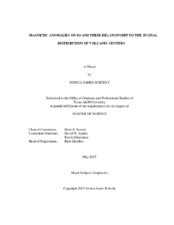| dc.contributor.advisor | Everett, Mark E | |
| dc.creator | Knicely, Joshua | |
| dc.date.accessioned | 2015-09-21T17:03:18Z | |
| dc.date.available | 2015-09-21T17:03:18Z | |
| dc.date.created | 2015-05 | |
| dc.date.issued | 2015-04-23 | |
| dc.date.submitted | May 2015 | |
| dc.identifier.uri | https://hdl.handle.net/1969.1/155183 | |
| dc.description.abstract | Forward modeling of planetary-scale magnetic anomalies due to induced crustal magnetization of Io is developed. My approach involves finite difference modeling of a temporally- and spatially-averaged steady state geotherm superimposed by the thermal evolution of an instantaneously emplaced volcanic pipe. Previous authors have estimated the steady state geotherm of Io. A slight adjustment to their parameters results in a preferred steady state geotherm that is colder at depth. The crustal magnetization is determined based on the calculated distribution of temperature and the ambient Jovian magnetic field. Magnetite is assumed to be the dominant magnetic mineral. Io resides in a time-varying magnetic field produced by Jupiter that is idealized herein as a uniform field of 1835 nT. The thermal data are converted to magnetization of discretized crustal prisms using a temperature-dependent susceptibility. Synthetic flyby data as would be observed by a satellite are generated along certain meridional swaths of Io’s surface. The swath locations are selected based on observed locations of volcanic centers, hotspots, and accumulations of ejected volcanic material.
This work produces a 1 D geotherm which remains at approximately the surface temperature to within a few kilometers of the thermal lithosphere/mantle boundary. This solution shows little dependence on porosity due to the depth at which rapid temperature change occurs. These conclusions hold for largely varying mantle temperatures. Silicate volcanic centers cool to temperature of sulfur volcanism rapidly and become indistinguishable within 10,000 years. The magnetic anomaly due to temperature variation is smaller than detectable in current conditions. If a crustal anomaly is detected by future satellite missions, it would suggest drastically different conditions at Io in the geologically recent past. | en |
| dc.format.mimetype | application/pdf | |
| dc.language.iso | en | |
| dc.subject | Io | en |
| dc.subject | magnetic anomaly | en |
| dc.subject | volcano | en |
| dc.title | Magnetic Anomalies on Io and Their Relationship to the Spatial Distribution of Volcanic Centers | en |
| dc.type | Thesis | en |
| thesis.degree.department | Geology and Geophysics | en |
| thesis.degree.discipline | Geophysics | en |
| thesis.degree.grantor | Texas A & M University | en |
| thesis.degree.name | Master of Science | en |
| thesis.degree.level | Masters | en |
| dc.contributor.committeeMember | Sparks, David W | |
| dc.contributor.committeeMember | Krisciunas, Kevin | |
| dc.type.material | text | en |
| dc.date.updated | 2015-09-21T17:03:18Z | |
| local.etdauthor.orcid | 0000-0001-7050-304X | |


